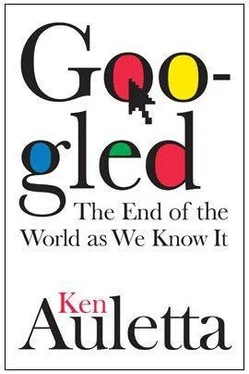When Google announced it was going public in the spring of 2004, it had to disclose its finances in an SEC filing. As Google’s director of global communications and public affairs, David Krane said reporters suddenly realized, “Holy shit, this is a business story we missed here!” Krane and his then boss, Cindy McCaffrey, were bombarded with queries, but because SEC rules require a “quiet period” from companies between the time they file and the time their stock goes on sale, they could not answer. Reporters would call and say, “I need to talk to Sergey. I need to talk to Larry. I need to talk to Eric.” The pressure “to get the Google story” was intense. Once, Krane spotted a photographer hiding behind a bush at the Googleplex, hoping to snap a picture of the founders.
On the eve of the auction, there was rampant speculation about the price the stock would fetch. On the day of the offering, August 19, Page did a highly unusual thing: he wore a suit, not his usual black T-shirt and jeans. He and Schmidt had flown overnight to New York to open trading on the NASDAQ floor. They were accompanied by investment bankers and a team of about ten Google executives, including Marissa Mayer. They went back to Morgan Stanley and watched, rapt, as their stock was traded, rising one minute, falling the next. They had suggested in their IPO a floor price of eighty-five dollars, but were hoping to better that. They were now engaged in a spectator sport, one with enormous personal financial consequences. “Will it break one hundred dollars? Will it break one hundred dollars? I kept asking,” said Mayer. She and Page and Schmidt and the others were mesmerized by the Morgan Stanley trader who spoke so fast to those on the trading floor that the Googlers found him unintelligible. They watched him finally coax the stock to settle in at one hundred dollars. At last, he rose from his chair and, as if he had put a baby to sleep, calmly told them, “It likes to trade at one hundred dollars.”
Page, Schmidt, Mayer, and David Krane hopped into a waiting SUV that took them to Google’s New York offices, which were then on West Fortieth Street. As soon as the car doors closed, recalled Mayer, Page pulled out his cell phone and announced, “I’m going to call my mom!” The others pulled theirs out and chorused, “I’m going to call my mom!” When they got to Google’s offices, Page and Schmidt and Mayer went back to work, meeting for ninety minutes with a team of engineers.
Where was Brin? He had stayed out of the public eye in Mountain View, working. Page and Schmidt had urged him to come to New York, but he refused, saying, “It would send the wrong message.” By treating this as a normal workday, he declared that the IPO was not about getting rich but about building Google.
The stock reached $108.31 the next day, and by January 31, 2005, had jumped above $200. It soared, in large measure, because investors had for the first time peeked at Google’s ledger sheet. They saw that Google’s revenues had shot up from $86 million in 2001 to $1.5 billion in 2003, and seemed destined to double by the end of 2004. Net profits reached $105.6 million in 2003, and were expected to almost triple the following year. They saw that the young AdSense program now contributed half of all revenues, and that Google raced well ahead of its two primary search competitors, with nearly twice the users of Yahoo and more than three times Microsoft’s. Google had little debt, and though Yahoo had terminated their search contract, it had generated only about 3 percent of Google’s revenues. They also saw that the Overture patent lawsuit hanging over Google was withdrawn by its corporate parent, Yahoo, which exchanged its warrants for 2.7 million Google shares. And they saw that Google’s skilled work force was deeply invested in their company’s success, with Google regularly setting aside about 12 percent of its revenues to award nearly 40 million stock options to its employees.
Envy raced through the corridors of traditional media companies. By the standards of media conglomerates (or investment bankers), Google’s compensation was extremely modest. Schmidt was the highest salaried employee at $250,000 and received a bonus of $301,556 in 2003, and Page and Brin each earned a salary of $150,000 and a bonus of $206,556. But the value of traditional media executives’ stock holdings were usually leaden. By contrast, a total of 19 million share options had been granted to Google employees, more than half of these at an option price of 49 cents per share, and none at a price above $15.95. When the stock price leaped with the IPO, it produced more than nine hundred Google millionaires. Eventually, four employees-Page, Brin, Schmidt, and Omid Kordestani-and the three outside directors would become billionaires. Andy Bechtolsheim, who signed the first check, owned 1.5 percent of Google’s stock, and David Cheriton of Stanford, who tirelessly promoted Google, owned 1.4 percent. Stanford University, which received stock and royalties from Google for their investment in Brin and Page, owned nearly 1.7 million shares. If the first thirty Google employees held their stock, said a knowledgeable insider, by 2008 they would each be worth about $500 million; the next seventy employees would each be worth about $100 million. Even Bonnie Brown, the first masseuse hired by Google in 1999, who smartly opted for stock options and a lower hourly rate, retired a millionaire and established her own foundation.
There was more to unsettle traditional media companies. On page 80 of the Google IPO was this strategic declaration: “We began as a technology company and have evolved into a software, technology, Internet, advertising and media company, all rolled into one.” And on page 11: “In addition to Internet companies, we face competition from companies that offer traditional media advertising opportunities.” Google went on to say that, increasingly, they would be vying with these media companies to induce advertisers to shift their ads online. In an appendix that accompanied the filing, Google produced a chart showing that while magazine and newspaper advertising declined between 2000 and 2007, and television ads only rose 8.8 percent, Internet advertising jumped 101.9 percent, becoming “the fastest growing medium for advertisers.”
While Wall Street focused on the money Google was making, Benjamin A. Schachter, then the senior Internet and video game analyst for UBS, focused on the dollars they were investing in computers and servers and data centers, two hundred million dollars in 2003 (and soon to climb to nearly three billion dollars annually). “This said they were doing much more than selling advertising. You don’t need that computing power for text searches. You need it for mobile phones and applications, for cloud computing.” A “cloud” of servers could store a consumer’s information and hold a suite of software products, including spreadsheets, word processing, and calendars.
Google has dozens of data centers all over the world (the exact number is a state secret at Google), and within these data centers are housed what may be the world’s most massive computer system, millions of PCs that have no keyboards or screens and are arranged in stacks and have been repurposed as servers to process searches. The servers in these data centers provide an array of software services that users can access from any device. By geographically spreading these data centers all over the world, Google became more efficient. “In a second, light can go around the world seven times,” said software engineer Matt Cutts, who joined Google in 2000. “That’s a couple of milliseconds between a data center on the East Coast and a data center on the West Coast or in Europe.” When we log onto Google, it instantly identifies our approximate geographical location from the Internet Protocol address on the browser that connects us to the Internet. Thus the query is dispatched to the closest data center, which produces a speedier result.
Читать дальше










